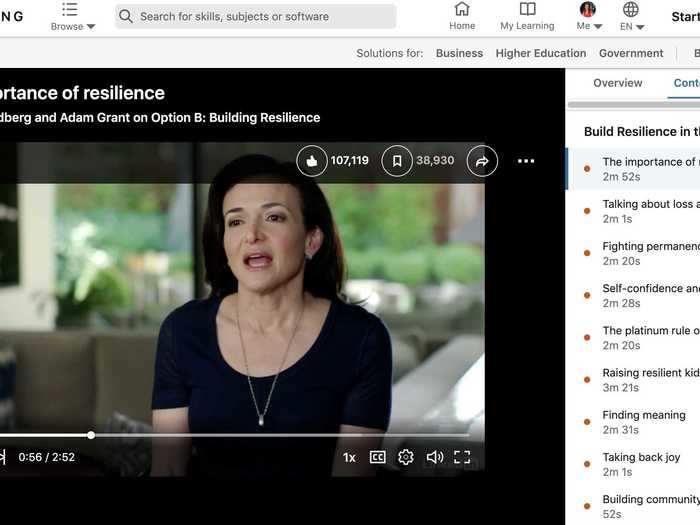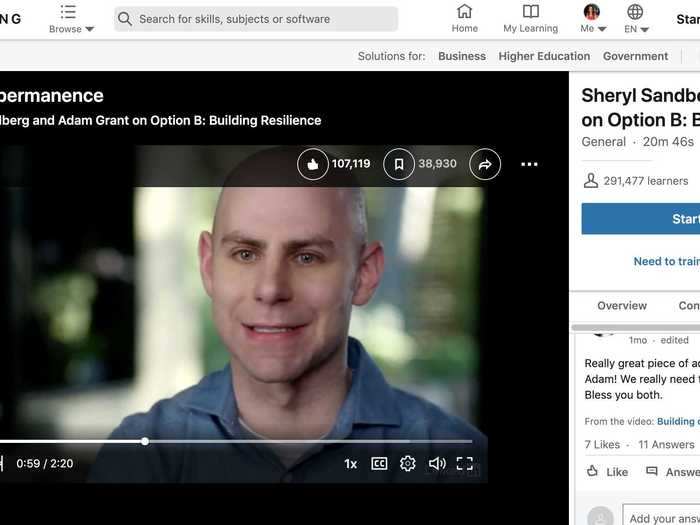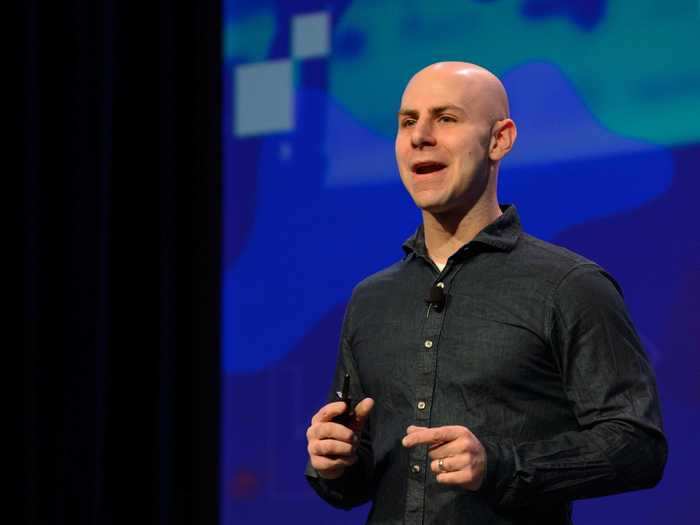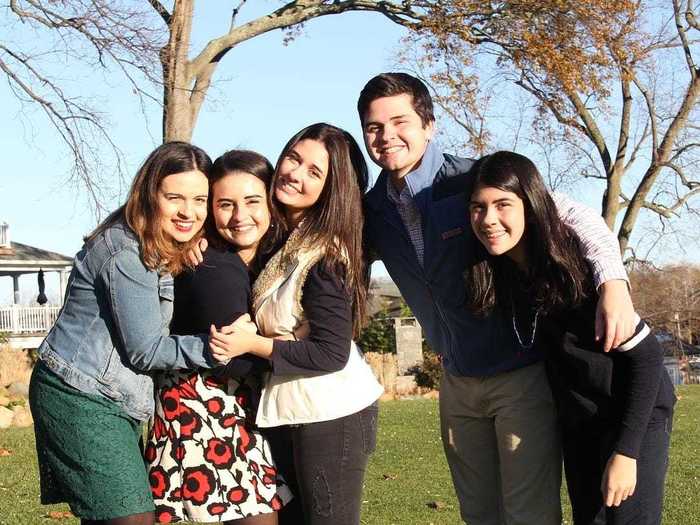Me (on the left), my three sisters, my brother, Matthew Ward, and my parents.Marguerite Ward
- My brother died of an accidental opioid overdose in May 2019 and Facebook COO Sheryl Sandberg's husband died in 2015 of a heart attack.
- A few weeks ago, Sandberg and I spoke about grief during a time when virtually everyone is experiencing it.
- That conversation inspired me to enroll in Sandberg's free 20-minute course she created with her "Option B" co-author, psychologist Adam Grant about how to heal from a major setback in life.
- The course taught me a few key lessons: that resilience is a muscle we build, and one great way to heal from trauma is to write down three things you're grateful for each night.
It's been a year of struggle for me and my family.
We recently marked the one-year anniversary of the day my younger brother died of an accidental opioid overdose. It's been a year of picking up the pieces of my shattered world. But it's also been a year of rebuilding and regrowth.
Anyone who's gone through trauma or grief will likely tell you the same thing: strength and resilience isn't the absence of hardship, but learning to grow despite it. It's a process that takes practice.
That's why, this past weekend, I signed up for a short course on strength and resilience taught by Facebook COO Sheryl Sandberg and her "Option B" co-author Adam Grant. It's a free, 20-minute video series that breaks down the most important points from their book, which is all about recovering from major setbacks in life, like the loss of a loved one. The course goes through several topics: What resilience is, how to build it, how to feel less emotionally isolated, and even how to raise emotionally resilient kids. You can sign up here on LinkedIn Learning.
A few weeks ago, Sandberg and I talked about our shared grief. Her husband, SurveyMonkey CEO Dave Goldberg, died of a heart attack in 2015. We talked about the mental shifts that need to happen in order to survive such a devastating loss.
We are not the only ones working through sadness right now. The family and friends of more than 100,000 Americans who've died from the coronavirus pandemic are also grieving — and there are millions more who are mourning the loss of their job, their identity, their sense of normalcy.
Learning how to build resilience over time is one major part of dealing with grief. It's a lifelong process. Sandberg and Grant's course does a great job of unpacking the most important points in the course. Here's what I learned about myself, my grief, and strength from the class.
Read the original article on
Business Insider
You aren't born with a fixed amount of strength — you build it over time.
Grant taught Sandberg that resilience isn't something a person is born with, but a skill you develop over with practice.
LinkedIn Learning
During the course, Sandberg discusses an earlier conversation when she asked Grant about the amount of resilience she had. She desperately wanted to know if she had enough. But Grant replied that there isn't a fixed amount of resilience, or strength, someone has. It's a muscle you work on to build.
I often wonder the same thing: Do I have enough inner strength to heal from the loss of my brother, my best friend? Grant's words, that strength is something a person can grow anytime, instilled hope in me.
"It's a skillset that we work on throughout our lives," Grant said. "It's really about learning, what does it take for me to find strength in a tough situation?"
One of the ways you build resilience is recognizing what you do have in life.
Gratitude can combat depression, Grant said.
LinkedIn Learning
When my brother died, our community rallied around us for support, helping organize a reception after the funeral and visiting us for weeks after to make sure we had emotional support. I realized how lucky we were to have this. Things could have been much worse if we were left largely on our own.
When Sandberg lost her husband, she couldn't imagine that her life could be any worse. Grant reminded her, however, that things could always be worse. Her husband could have had a heart attack while driving their kids.
"It never occurred to me that I could have lost all three of them in an instant, not just one. And actually the minute you say that you're like 'OK. I'm alright. Thank God my children are alive,'" Sandberg said.
Gratitude helps put even the most horrible situations in perspective.
Know that your life will not always be this difficult.
Simple language changes like saying "I'll sometimes feel sad," instead of "I'll always feel sad," can change your outlook on your future.
AP Photo/Eric Risberg
In the series, I learned about the term "affective forecasting," which is when we predict how we'll feel in the future. Usually, we predict that our grief, depression, or anxiety will last forever. Sandberg recalled feeling this way.
The trick is to challenge those beliefs by changing our inner dialogue. Change "always" and "never" with "sometimes" and "lately," Grant suggests.
These tricks are helpful on days when my grief flares up. Challenging your inner dialogue can help make the difficult moments less difficult.
"I want anyone going through hardship, anyone going through trauma to know, it will not always feel this bad," Sandberg said.
Practicing gratitude can drastically change the way you handle loss or adversity.
Grant encourages everyone to write down three things they're grateful for each night.
Jim Bennett/Getty Images
Whether it's blaming ourselves for something we had no control over or going over past mistakes, trauma and grief can do a number on one's personal psyche. In order to combat this, Grant and Sandberg stress the importance of treating yourself with self-compassion. In other words, approach yourself with the same kindness you would show a friend.
When Sandberg was struggling, Grant told her to write down three things every day that she accomplished, even if it was small things like crying less than normal in a meeting or making tea for herself. This habit, he said, can help boost your confidence.
"It is transformative," Sandberg said.
The biggest takeaway for me is that learning to cope with grief is a lifelong journey, and that it takes daily routines to heal.
Me (on the left), my three sisters, and my brother, Matthew Ward.
Aileen Brown
Sandberg said she still writes down three things she is grateful for every night, and that stood out to me. It's been five years since she lost her husband, and still she has daily routines to help in her healing process. That's a sign of strength — she knows healing takes a lifetime, perhaps more — and she's taking the steps to ensure she's building strength daily.
That showed me that I need to do the same, to build habits that help me grow. In addition to trying Sheryl's method, I'm going to try to read more on grief and the journey.
I'm also going to revisit this course when I need a refresher. For me, the most useful part of the video may be the "replay" button.





